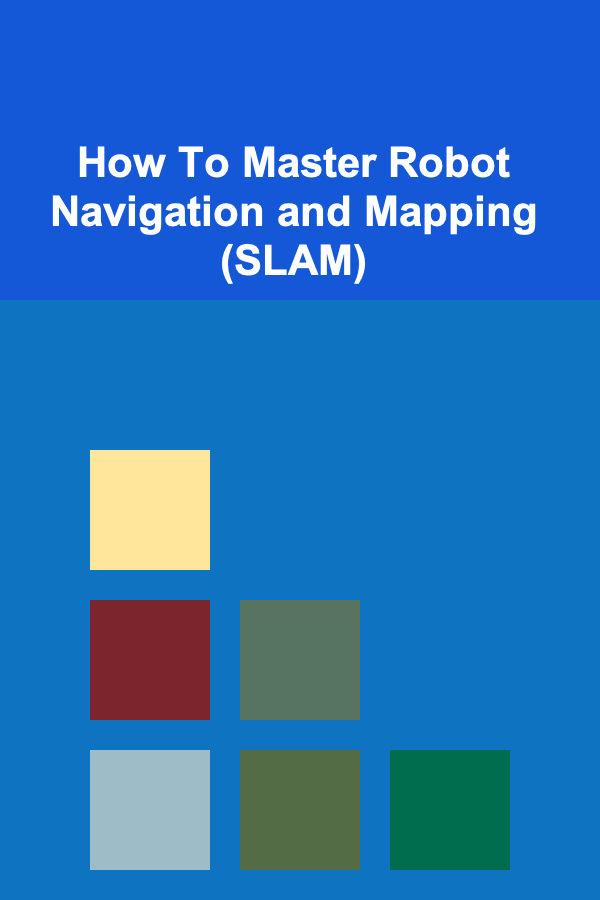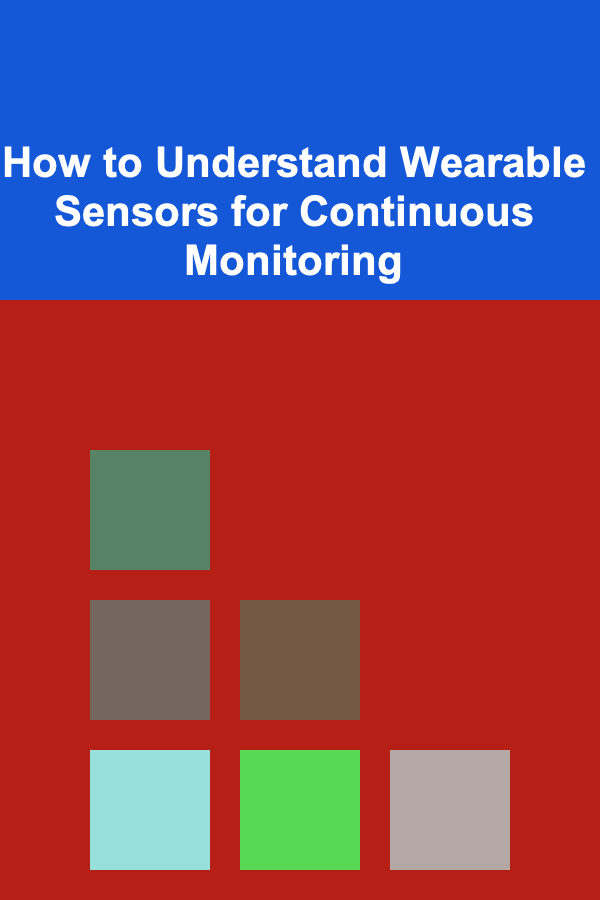
How To Master Robot Navigation and Mapping (SLAM)
ebook include PDF & Audio bundle (Micro Guide)
$12.99$10.99
Limited Time Offer! Order within the next:

In the world of robotics, SLAM (Simultaneous Localization and Mapping) is a critical concept that powers robots to navigate and understand their environment autonomously. Whether it's a self-driving car, a delivery robot, or a drone, robots need the ability to navigate through complex environments, create maps, and understand their location within those maps in real-time. This article aims to provide a deep dive into the concept of SLAM, its components, algorithms, and practical applications in mastering robot navigation and mapping.
What is SLAM?
Simultaneous Localization and Mapping (SLAM) is the process of building a map of an unknown environment while simultaneously keeping track of the robot's location within that map. The challenge arises because, in the early stages, the robot does not have a map, nor does it know its location. SLAM allows the robot to construct the map and determine its position within that map without needing an external reference, such as GPS.
SLAM typically involves two main tasks:
- Localization: Estimating the robot's position and orientation relative to a map.
- Mapping: Creating a representation of the environment in the form of a map that the robot can use to navigate.
To achieve this, SLAM relies on sensors (like LIDAR, cameras, and IMUs), algorithms, and computational techniques that help the robot observe, interpret, and act upon its surroundings.
Key Concepts in SLAM
Before diving into how to master SLAM, it's essential to understand the fundamental concepts behind it:
1. Robotic Sensors
SLAM requires a variety of sensors to gather data about the robot's surroundings. These sensors provide input that is used to create the map and estimate the robot's position. Some of the most commonly used sensors are:
- LIDAR (Light Detection and Ranging): LIDAR provides accurate distance measurements by emitting laser beams and measuring the time it takes for the beams to return after striking an object.
- Cameras: Both monocular (single camera) and stereo (two cameras) vision systems can be used to capture images of the environment. These images can then be processed for feature detection, object recognition, and depth estimation.
- IMU (Inertial Measurement Unit): IMUs provide information about the robot's acceleration and angular velocity, helping to estimate the robot's motion.
- Ultrasonic Sensors: Often used in simpler robots, ultrasonic sensors detect objects by emitting sound waves and measuring the time it takes for the sound to reflect off objects.
2. Map Representation
In SLAM, the environment is usually represented in one of two ways:
- Grid Maps: These are two-dimensional grids where each cell represents a small section of the environment. The grid can be marked as either occupied or free, and these maps are often used in robots that navigate through indoor environments.
- Feature-based Maps: These maps represent the environment using specific features (such as corners, walls, or landmarks). Feature-based maps are often used for outdoor environments or larger, more complex areas.
3. Localization
Localization is the process of determining where the robot is relative to its environment. This can be achieved by continuously comparing the sensor data to the map that the robot is building. The robot must estimate its position in real-time while updating its surroundings as it moves.
4. Motion Models and Odometry
Odometry refers to the estimation of the robot's position based on its previous positions and the movements it has made. Robots typically use wheel encoders or IMUs to estimate their motion. However, odometry alone is prone to errors due to factors like wheel slippage or uneven surfaces. Thus, SLAM combines odometry with sensor data to improve the robot's localization accuracy.
SLAM Algorithms
SLAM is a challenging problem in robotics due to the need to simultaneously estimate the robot's location and build a map in real-time. Over the years, various algorithms have been developed to tackle the SLAM problem. The choice of algorithm depends on the type of robot, its sensors, the environment, and the computational resources available.
1. Extended Kalman Filter (EKF) SLAM
One of the earliest and most well-known SLAM algorithms is the Extended Kalman Filter (EKF). EKF SLAM works by maintaining an estimate of both the robot's state (position and orientation) and the map (locations of landmarks). It uses a probabilistic approach to model uncertainties in the robot's motion and sensor measurements.
- Pros: EKF SLAM is mathematically well-founded, and it can handle non-linearities in the motion and measurement models. It works well for small environments with a limited number of landmarks.
- Cons: EKF SLAM can become computationally expensive for large maps due to the need to update a large covariance matrix. It also struggles with large environments or when the number of landmarks increases significantly.
2. FastSLAM
FastSLAM is another SLAM algorithm that is based on a particle filter approach. It breaks down the SLAM problem by using a set of particles, where each particle represents a possible robot path and a set of landmarks. The robot's position and map are updated for each particle.
- Pros: FastSLAM works well in large environments and can handle a large number of landmarks more efficiently than EKF SLAM. It is highly parallelizable and can be used in real-time applications.
- Cons: The algorithm can be sensitive to initial conditions and requires a large number of particles for accurate estimation, which can be computationally intensive.
3. Graph-based SLAM
Graph-based SLAM, also known as Pose Graph SLAM, represents the robot's path and the map as a graph. Each node in the graph represents the robot's pose at a particular time, and each edge represents a constraint based on the robot's movements or sensor measurements.
- Pros: Graph-based SLAM is highly efficient in handling large-scale environments. It is particularly well-suited for applications like autonomous vehicles or large indoor robots that require high precision.
- Cons: While graph-based SLAM works well for large environments, it can be sensitive to loop closure errors. Correcting loop closure errors (when the robot revisits a previously mapped area) can be computationally expensive.
4. Visual SLAM
Visual SLAM uses cameras as the primary sensor for mapping and localization. By extracting features from images (such as edges, corners, or key points), the robot can localize itself and create a map based on visual data.
- Pros: Visual SLAM can provide detailed maps of environments with rich textures and structures. It works well in large environments, where cameras are more effective than LIDAR or ultrasonic sensors.
- Cons: Visual SLAM can struggle in low-light conditions, or environments that lack distinct visual features. It also requires significant computational power for real-time processing.
5. LIDAR-based SLAM
LIDAR-based SLAM relies on LIDAR sensors to create precise 3D maps of the environment. LIDAR provides highly accurate distance measurements and is especially effective in environments with complex geometries.
- Pros: LIDAR-based SLAM provides high-precision maps and is less affected by environmental conditions such as lighting. It's highly reliable in both indoor and outdoor environments.
- Cons: LIDAR sensors are typically more expensive than cameras or ultrasonic sensors. They also have limitations in certain environments, such as areas with significant clutter or where fine details are important.
Mastering SLAM
Mastering SLAM requires both theoretical knowledge and practical experience. Here are some steps you can take to master robot navigation and mapping using SLAM:
1. Understand the Fundamentals of Robotics
To work with SLAM, it's crucial to have a strong understanding of robotics concepts, such as kinematics, dynamics, motion planning, and control. SLAM builds on these concepts by integrating them with sensors and algorithms.
2. Study Sensor Technologies
Since SLAM heavily relies on sensors, it's important to have a deep understanding of how different sensors (LIDAR, cameras, IMUs) work and their limitations. Understanding the strengths and weaknesses of various sensors will help you choose the right ones for your application.
3. Learn the Key SLAM Algorithms
To effectively use SLAM, you need to learn the various SLAM algorithms and understand their strengths and limitations. Implementing these algorithms in code will help you better grasp their inner workings. Common programming languages for implementing SLAM include Python, C++, and MATLAB.
4. Experiment with Real-World Robots
To truly master SLAM, hands-on experience with real-world robots is essential. Experimenting with robots equipped with different sensors will allow you to gain insights into the challenges and limitations of real-time SLAM implementations.
5. Explore Advanced Topics
Once you've mastered the basics, dive into advanced topics such as multi-robot SLAM, real-time optimization techniques, and the integration of machine learning into SLAM systems. Machine learning can help improve map generation and localization accuracy by allowing the robot to learn from its environment and experiences.
Applications of SLAM
SLAM has a wide range of applications across various industries. Some of the most notable applications include:
- Autonomous Vehicles: SLAM is crucial for self-driving cars to map their environment, avoid obstacles, and navigate safely.
- Robotic Mapping and Surveying: Drones and robots use SLAM to create 3D maps of areas that are too dangerous or difficult for humans to access.
- Warehouse Automation: Robots in warehouses use SLAM to navigate aisles and shelves for efficient inventory management and package delivery.
- Medical Robots: SLAM enables surgical robots to navigate the human body with high precision.
Conclusion
Mastering robot navigation and mapping (SLAM) is a complex but rewarding endeavor. By understanding the core concepts, algorithms, and practical applications, you can build robots that are capable of navigating and interacting with their environments autonomously. Whether you are developing self-driving cars, drones, or industrial robots, mastering SLAM is an essential skill that will enable you to push the boundaries of robotics and automation.

How to Make Money Online as a Voice User Interface (VUI) Designer: 10 Actionable Ideas
Read More
How to Prevent Water Leaks in Your Home
Read More
How to Reflect on Past Seasons to Improve Future Organization
Read More
How to Understand Wearable Sensors for Continuous Monitoring
Read More
How To Master 3D Printing for Board Game Inserts
Read More
How to Develop a Positive Outlook
Read MoreOther Products

How to Make Money Online as a Voice User Interface (VUI) Designer: 10 Actionable Ideas
Read More
How to Prevent Water Leaks in Your Home
Read More
How to Reflect on Past Seasons to Improve Future Organization
Read More
How to Understand Wearable Sensors for Continuous Monitoring
Read More
How To Master 3D Printing for Board Game Inserts
Read More